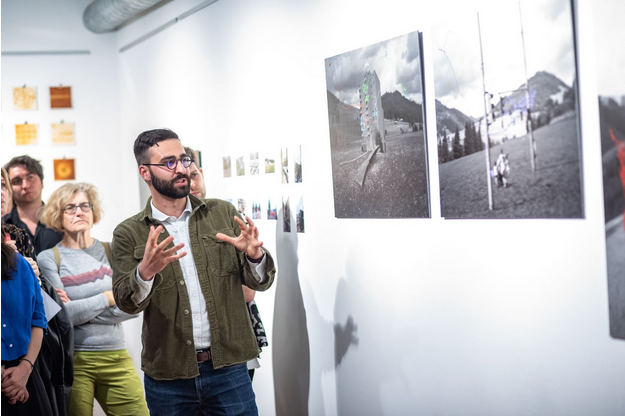Daniel Barabasi is a graduate student pursuing a Ph.D. in the Harvard Biophysics Graduate Program, working in the lab of Florian Engert, researching innateness in neurodevelopment and artificial intelligence. He has an interest in the relationship between art and science, and together with photographer Balázs Csizik recently opened an exhibit on the intersections of neuronal, urban, and societal growth patterns in Budapest, entitled “Biophilia.” HBI invited him to share more about his exhibit and how the fusion of art and science within it came to be.
Creating Biophilia
By Dániel Barabási
As scientists, we rationalize our choice of research projects in many ways. I prefer to work on questions that captivate even in a boisterous bar environment. The strategy has been great for recruiting co-authors, but, most recently, it helped me find a co-exhibitor: Balázs Csizik.
I had met Balázs, an artist and urbanist, during a family visit to Budapest, and began sharing with him selected visually and conceptually intriguing scientific notes. When I showed him 2-photon recordings of early neural activations in zebrafish, recently collected with Gregor Schuhknecht in the Engert lab, Balázs proposed that we plan a joint exhibition. His suggestion was flattering, but initially, I didn’t quite take it to heart. Yet, a week later, I woke to a text that we had a venue: our Biophilia exhibit, a homage to late Harvard Professor E.O. Wilson, would open on May 11th, 2023 at the K11Lab in downtown Budapest. Just 8 short months away.
Balázs and I soon sat down to focus our dialogues on the parallels and contrasts in urban and biological growth into milestones for our collaborative pieces. We chose two central themes for our work: first, we would use Balázs’ distinctive constructivist, Bauhaus-inspired style to depict key concepts of neurodevelopment. This included developing modular representations of Waddington landscapes for cell identity formation, morphogenesis, cell-cell recognition rules, and pruning, fit for the canvas. Second, we aimed to highlight the tension between natural social dynamics and urban landscapes by connecting the two with neurons, thereby physically embodying Biophilia – the inherent human urge to connect with nature and other forms of life!
I had expected a grueling, tortured creative process– an assumption based on my knowledge of the lives of artists like Pollock, Van Gogh, and Basquiat – only to find that the trajectory of an artistic endeavor mirrored that of a scientific project. Over the next few months, we updated shared Google Docs, logged in to Zoom meetings, asked peers for feedback, and finally submitted our materials for – not publication, but printing. Picking up our finalized pieces was a surreal experience. It was akin to seeing proofs for a paper, a mixed feeling of exhilaration and the strange realization that a project, which consumed several months, was nearing its conclusion.
Yet, any lingering cynicism about the process melted away as I began to see the impact our exhibit had on others. The lead singer of a local rock band told me he was inspired by our work to develop a fledgling voice memo titled “Embryo” into a full-fledged track, an acoustic narration of embryogenesis set to piano music. After a guided tour for an actor, his evening performance spiraled into a debate about free will in the context of deterministic development, a dispute I was brought onstage to settle. Perhaps most touching was hearing from high school and undergraduate students, who saw new possibilities in research and art after seeing their science curriculum on the canvas.

Photo Credit: Gábor Dala
Through this journey, I noted a final parallel between art and science: both lie in the eye of the beholder. Thus, all that can transcends the pleasure of making our own discoveries is witnessing the amazing inspirations they can kindle in others.

Left to Right: Zsófia Máté (Curator), Balázs Csizik and Dániel Barabási (co-exhibitors), Dóri Badics (Contributing Artist), Noémi Viski (Gallery Director)
Photo Credit: Dani Gál
News Types: Community Stories
